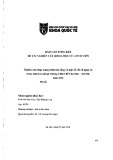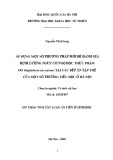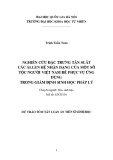
Hindawi Publishing Corporation
EURASIP Journal on Advances in Signal Processing
Volume 2009, Article ID 837601, 16 pages
doi:10.1155/2009/837601
Research Article
Network Anomaly Detection Based on Wavelet Analysis
WeiLuandAliA.Ghorbani
Information Security Center of Excellence, The University of New Brunswick, Fredericton, NB, Canada E3B 5A3
Correspondence should be addressed to Wei Lu, wlu@unb.ca
Received 1 September 2007; Revised 3 April 2008; Accepted 2 June 2008
Recommended by Chin-Tser Huang
Signal processing techniques have been applied recently for analyzing and detecting network anomalies due to their potential to
find novel or unknown intrusions. In this paper, we propose a new network signal modelling technique for detecting network
anomalies, combining the wavelet approximation and system identification theory. In order to characterize network traffic
behaviors, we present fifteen features and use them as the input signals in our system. We then evaluate our approach with the 1999
DARPA intrusion detection dataset and conduct a comprehensive analysis of the intrusions in the dataset. Evaluation results show
that the approach achieves high-detection rates in terms of both attack instances and attack types. Furthermore, we conduct a full
day’s evaluation in a real large-scale WiFi ISP network where five attack types are successfully detected from over 30 millions flows.
Copyright © 2009 W. Lu and A. A. Ghorbani. This is an open access article distributed under the Creative Commons Attribution
License, which permits unrestricted use, distribution, and reproduction in any medium, provided the original work is properly
cited.
1. Introduction
Intrusion detection has been extensively studied since the
seminal report written by Anderson [1]. Traditionally, intru-
sion detection techniques are classified into two categories:
misuse detection and anomaly detection. Misuse detection
is based on the assumption that most attacks leave a set
of signatures in the stream of network packets or in audit
trails, and thus attacks are detectable if these signatures can
be identified by analyzing the audit trails or network traffic
behaviors. However, misuse detection approaches are strictly
limited to the latest known attacks. How to detect new attacks
or variants of known attacks is one of the biggest challenges
faced by misuse detection.
To address the weakness of misuse detection, the concept
of anomaly detection was formalized in the seminal report of
Denning [2]. Denning assumed that security violations could
be detected by inspecting abnormal system usage patterns
from the audit data. As a result, most anomaly detection
techniques attempt to establish normal activity profiles by
computing various metrics and an intrusion is detected when
the actual system behavior deviates from the normal profiles.
According to the characteristics of the monitored sources,
anomaly detection can be classified into host-based and
network-based. Typically, a host-based anomaly detection
system runs on a local monitored host and uses its log files or
audit trail data as information sources. The major limitation
of host-based anomaly detection is its capability to detect
distributed and coordinated attacks that show patterns in the
network traffic. In contrast, network-based anomaly detec-
tion aims at protecting the entire networks against intrusions
by monitoring the network traffic either on designed hosts or
specific sensors and thus can protect simultaneously a large
number of computers running different operating systems
against remote attacks such as port scans, distributed denial-
of-service attacks, propagation of computer worms, which
stand for a major threat to current Internet infrastructure. As
a result, we restrict our focus to network anomaly detection
in this paper.
According to Axelsson, the early network anomaly detec-
tion systems are self-learning, that is, they automatically
formed an opinion of what the subject’s normal behav-
ior is [3]. Such self-learning techniques include the early
statistical model-based anomaly detection approaches [4–
6], the AI-based approaches [7] or the biological models-
based approaches [8], to name a few. Although machine
learning techniques have achieved good results at detecting
network anomalies so far, they are still faced with some major
challenges, such as “can machine learning be secure”? [9],
“behavioral non-similarity in training and testing data will
totally fail leaning algorithms on anomaly detection” [10],
and “limited capability for detecting previously unknown






























